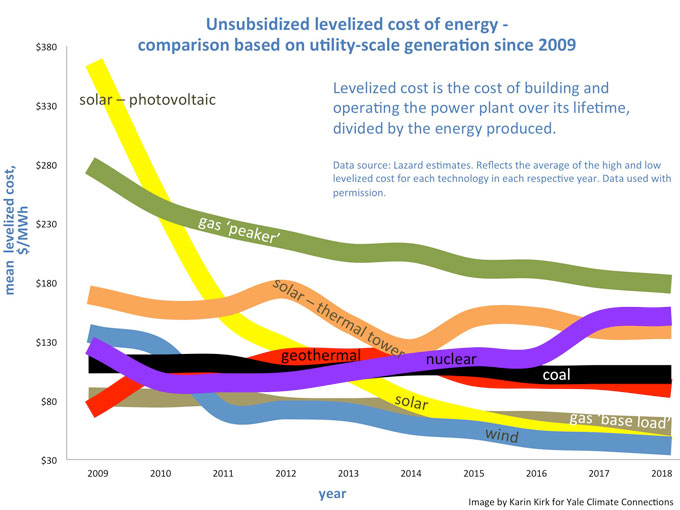Renewable energy innovations symbolize what’s great about America. Discussing them provides opportunities for climate dialogue.

Energy use is the biggest cause of climate change, and it’s the first place we should look for solutions. It’s also a smart angle for talking about climate change, because it’s easy to find agreement on issues like improving energy efficiency, reducing pollution, cleaning up our energy supply, and reducing reliance on unstable foreign supplies.
But energy can be a bit of a double-edged sword. The very reason that some people reject climate change is that they fear some of its solutions, such as regulations on carbon, or government subsidies for clean energy, pose risks to established fossil-fuel based ways of life.
The good news is that it’s not hard to have positive conversations about energy. In doing so, one can leverage key strategies from previous articles in this series. For example, why not instill optimism by reminding people that Americans are proven innovators and problem-solvers, or by pointing out how America ought not get beat out by other nations in the global race toward modernizing the energy system? By emphasizing shared values, you can structure a dialogue around areas of mutual agreement.
The following are some common myths about renewable energy, along with a fact check, and a rebuttal designed to be inclusive and broadly appealing.
Renewable energy is inexpensive
The myth: “Wind and solar are FAR too expensive! Why should MY energy bill skyrocket for the sake of fake news about global warming?”
Fact check:
The overall costs of electricity generation from different sources can be compared using a measure called the levelized cost of electricity. The Energy Information Administration and Lazard financial analysts are two reliable sources of information about electricity pricing. Similar, but easier-to-read information can be found in a summary at Scientific American, or these infographics from Lazard. Either route leads to the same conclusions: The price of renewables has fallen to the point that they are cheaper than conventional fossil fuels.

Onshore wind turbines and utility-scale photovoltaic solar are essentially tied for the lowest cost of unsubsidized electricity for new power generation. Natural gas is not far behind, and the variation in prices between those three will likely depend on geographic location.
Add in tax credits for renewable energy, or the potential for carbon pricing, and the price tags of wind and solar look even better.
A friendly response: “I completely agree with you that the price of energy is important. High energy prices affect us all, every day. That’s why it’s such good news that renewable energy sources have fallen in price and are now cheaper than, or similar to, the price for conventional power plants. On-shore wind turbines and large-scale solar power are among the cheapest sources of energy today, and that’s not even considering subsidies, tax credits, or the potential costs of carbon pricing. Add in those factors, and the price of renewables is even more attractive.
This is why the U.S. Department of Energy expects renewable energy to be the fastest growing source of electricity in the next few years.”
Wind turbines return far more energy than it takes to build them
The myth: “Wind farms are a scam. They are not green and actually use more electricity than they produce. Stupid Idea.”
Fact check:
This myth doesn’t pass the smell test. If wind turbines were a net loss on their energy footprint, no one would build them because they’d be uneconomical. But as the response to the previous myth shows, wind energy is a winner when considering the total life cycle costs of construction and maintenance.
All types of energy infrastructure require energy to build. The ratio of energy generated compared to the energy sunk into the process is called the energy return on investment, or EROI. A 2010 study of wind turbines around the world shows that wind turbines generate 20-25 times the amount of energy that goes into making them; and a 2014 report pegs the EROI for wind at 18-20.
How does that compare to other forms of electricity? Coal comes in at around 18, while natural gas falls somewhere in the range of 7 to 15. Caution must be taken when looking at raw EROI numbers from fossil fuels, because some publications report the amount of energy produced at the wellhead or minemouth, which does not tell the full story. When fossil fuels are burned to generate electricity, thermodynamic losses cut the usable energy by 30 to 45 percent.
An article at Carbon Brief offers a summary of the energy required to generate electricity from various sources.
The math may be tricky, but there’s no question that wind turbines clearly generate far more energy than it takes to build them. And that’s one good reason that wind energy is growing rapidly, worldwide.
A friendly response: “That’s a good point, that we need to consider the amount of energy it takes to build our energy infrastructure, whether it’s a wind farm or a coal mine. And you are quite correct that any source of energy that doesn’t actually produce energy is unworkable. But, the good news is that wind turbines return 18 to 25 times the amount of energy it takes to build them. Interestingly, wind has a better return on energy investment than coal or natural gas.”
Renewable energy can still deliver even without sunshine or wind
Myth: We could die without coal. Renewable energy is not reliable. What happens when the Sun doesn’t shine, or the wind stops blowing? I guess we all just sit in the dark?
Fact check:
Storage of renewable energy is a hot topic in energy research. While wind farms and solar arrays are scaling up worldwide, we also need to become better at storing energy so that it’s available on-demand. Turning the intermittency of wind and solar into the ‘baseload’ energy required by the grid is an engineering challenge that offers enormous reward to those that solve it. So there is vigorous competition to optimize energy storage.
While traditional batteries are one option, there are other ways to store energy. A particularly elegant solution is pumped hydro, which uses surplus wind energy to pump water uphill. When energy is needed, the water is released and allowed to flow downhill, spinning turbines along the way. One advantage of pumped hydro is that it can respond nearly instantly to the ebbs and flows of energy demands across the grid. While all forms of energy storage result in some loss of energy (damn you, thermodynamics), pumped hydro is among the most efficient.
Concentrating solar power, also called solar thermal, uses mirrors to concentrate the Sun’s energy. Thermal energy can be stored in molten salt, which has an exceptional ability to absorb and retain heat, and can be used to spin steam-powered turbines 24 hours a day.
Thanks to concentrating solar power, the mining industry in Chile will soon be energized by 24/7 solar energy. Solar thermal plants are also being constructed in Australia and Dubai, and in all three of these cases the electricity price is among the cheapest in the world.
Technologies like batteries, pumped hydro, and concentrating solar power are advancing rapidly, in part because there are tremendous financial incentives to develop low-carbon, baseload energy sources. It would be unwise to assume the solutions we have on hand today will remain static over the coming decade. The innovation spurred by energy storage technology makes an appealing rallying point: a great America is a competitive America.
A friendly response: “You raise a really good point. Generating energy is only half the battle, because we need to deliver it when and where it’s needed. I agree that a lot of people overlook this important detail. While some people see energy storage as an insurmountable obstacle, others recognize it as a prime opportunity. Storage of renewable energy is a solvable problem. Look at pumped hydro, for example, which uses gravity as a giant battery. People who develop these solutions are going to become fabulously wealthy. Do you think America should become the world leader in storing wind and solar energy? Or should we let other nations take charge? Americans are proven innovators and problem solvers. Let’s use our ingenuity to get ahead in the global race toward modern energy.”
Regrettably, partisan politics (with some significant help from dark money) has made clean energy into a topic that is often mischaracterized and poorly understood. Fortunately, though, there are many ways to clear the air and build support for clean energy, using ideals that practically all Americans hold dear.
We’re not done with energy myths. The next installment of this series will unpack more clean energy misconceptions.
